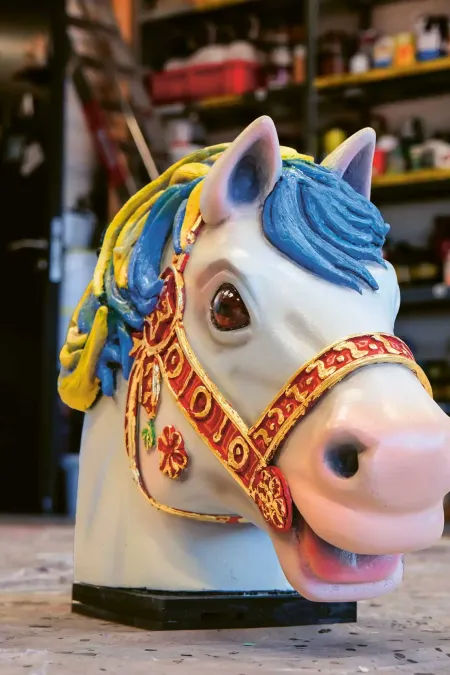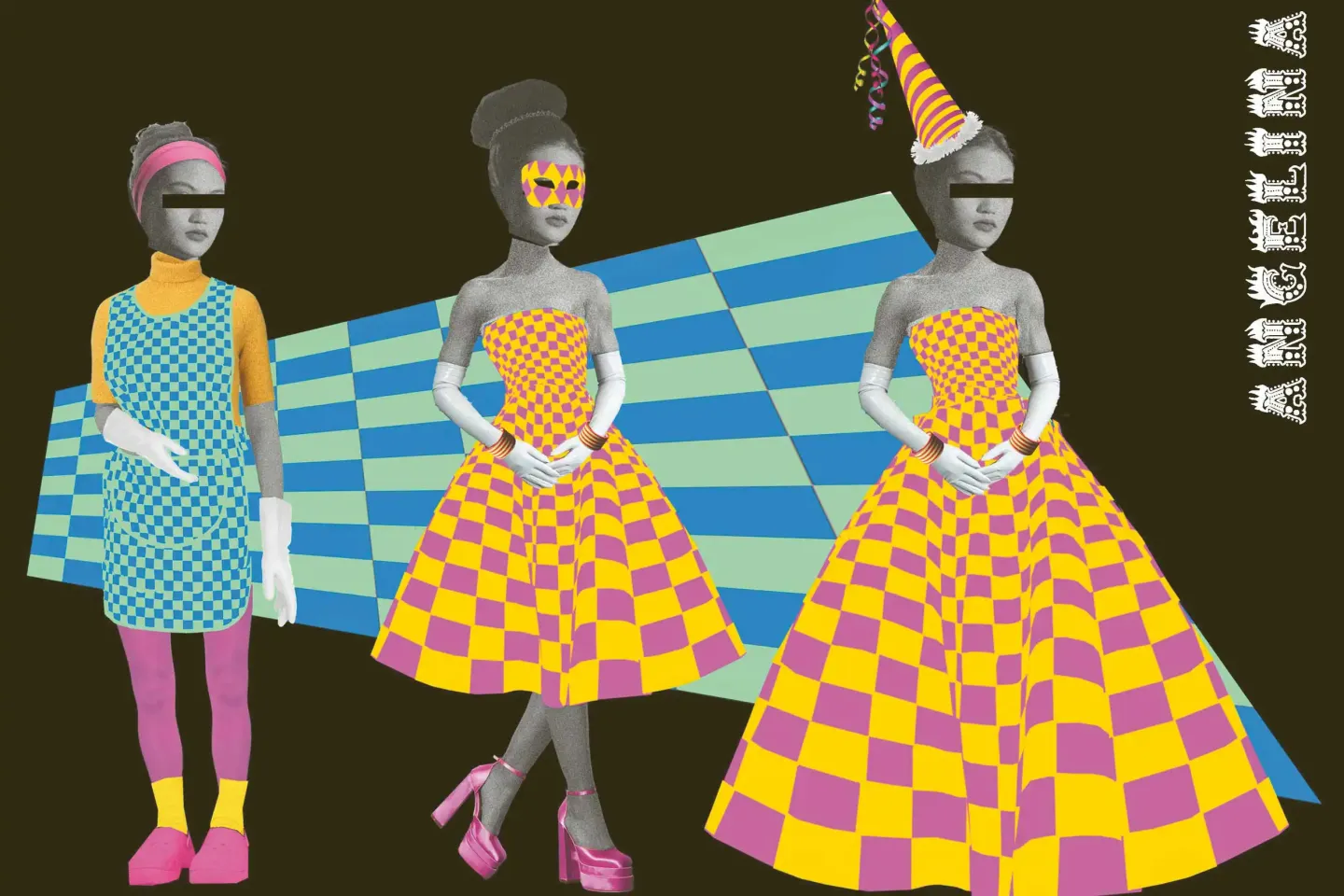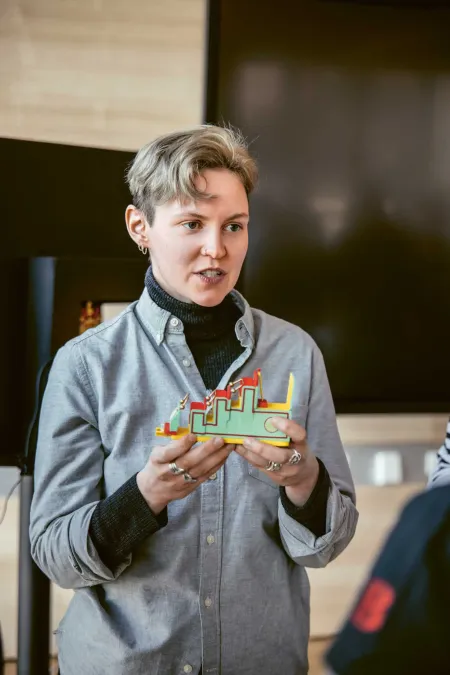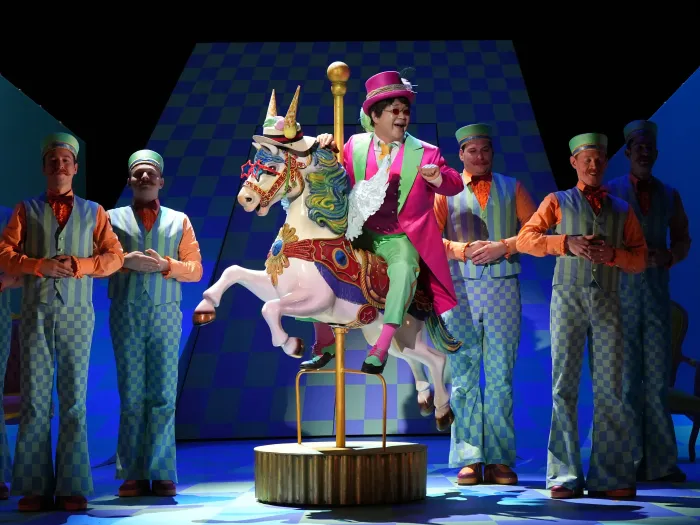Text: Jutta Berger
The text was published in edition 3 (06/25).
Reading time 3 Min.
A bit of funhouse, a bit of Prater
Unconventional and imaginative – that’s how the stage appears for Gioachino Rossini’s fairytale opera La Cenerentola. A delightful challenge for the production design team.

Nostalgic fairground or a Pop Art funhouse? Cinderella or Alice in Wonderland? Willy Wonka or Alidoro? La Cenerentola, as staged by British director Amy Lane, is not an either-or – it’s all of it at once. For the Theater am Kornmarkt, Anna Reid has created a colorful stage design for Rossini’s opera buffa, breaking away entirely from cinders, palaces, and glass slippers.
A colorful potpourri of characters
A large-scale checkerboard pattern spans the floor and walls. Its strict geometry is disrupted by candy-colors and perspective distortion. Vanity mirror bulbs and neon signs flash. On the chessboard, colorfully dressed characters frolic, each with a “twin” recognizable by matching colors and patterns. The motif continues in the costumes. “A special challenge for our tailors,” emphasizes Susanna Boehm, Head of the Art Department at the Bregenzer Festspiele, “because the fabric has to align precisely with the strict geometric design.”
Amy Lane brings the fairy-tale figures of Cenerentola into a fantasy realm. Alidoro, the prince’s wise advisor in search of a bride, becomes a wise guardian of wisdom, master of time, and champion of justice. Cenerentola is a cleaner who becomes Prince Ramiro’s dream partner. The sought-after bachelor is bored of the glittering world around him. Ramiro no longer wants to be a celebrity nobleman but an innovative statesman. Don Magnifico, the stepfather of the beautiful and clever Cenerentola and father of the cunning twin daughters Tisbe and Clorinde, appears as a booze-loving fairground fortune teller. The twins embody superficiality and, driven by greed, each attempt to claim the prince for herself. And then there’s Dandini –Ramiro’s best friend – who storms across the stage as a party animal and jokester.
Before any of this comes to life, months are spent in the Festspielhaus pondering, debating, and calculating. “The leading team makes an initial concept proposal in autumn of the previous year,” Head of the Art Department Susanna Boehm. “That proposal is then reviewed for feasibility. The process of implementing artistic ideas is always lengthy – due to the dynamic nature of the production process,” says Boehm. Often, it isn’t completed until the final orchestra rehearsal, just days before the premiere. “Sometimes, it’s only during rehearsals that we realize a costume or prop doesn’t work.” She offers an example: “Imagine a costume repeatedly getting caught on a ladder that the singer has to climb. Then we have to decide whether to modify the dress or the ladder.”

Costume of the character Angelina from La Cenerentola – Bright colors and geometric patterns run through Anna Reid’s designs.
Sparkling donkey and money changer
The design for La Cenerentola is especially imaginative – the audience is meant to be drawn into a wondrous world of illusions. A major part of the work involves searching for and creating the right props. One such prop is a little glittery donkey with a feather boa that looks like it came straight from a long-lost carousel. Originally discovered as a wooden carousel horse on an online flea market, it was transformed into a stage-ready donkey in the Bregenzer Festspiele workshops. A real eye-catcher is the roller coaster, symbolizing the ups and downs of life of the characters. But since this is more Willy Wonka than the Prater Vienna we call it a “roller coaster” in Cenerentola. As the stage at the Theater am Kornmarkt is too small for a full ride, the concept is symbolized by a single car.

A magical rollercoaster ride between glitter and popcorn
The car is built in the Bregenzer Festspiele workshops. Before carpenter Shantira Kosol uses the CNC milling machine to cut the components from wooden boards, she prepares a true-to-scale 3D drawing. “The car must accommodate seven people, which means it needs to be fairly large while still fitting on the relatively small stage,” Kosol remarks, outlining the core challenge. “That’s why the car is built at a steep angle, almost like a staircase – so that all passengers are clearly visible.” Once the carpentry is done, the specialists from the scenic painting team take over and add color, while the lighting department installs the lamps.
Anna Reid (Set and Costume Design) with the roller coaster model. Her designs are marked by bold colors and geometric patterns.
Fairground flair in every detail
What would a fairground be without all the bright colorful, sparkling, and sticky little details? Cotton candy, candy canes, popcorn – all loud and colorful – are on full display. Admission tickets to this colorful setting of the fantasy world are dispensed, just like in the old days, from a money changer. “I wasn’t familiar with that term either,” laughs Susanna Boehm.
Older audiences might recall these devices from train or tram rides. The conductor would carry one in a leather satchel to sort different coins meticulously. They also had a slot for tear-off tickets. “That’s exactly the kind of device – with a ticket roll – our director wanted. Unfortunately, we couldn’t find a used one, so now we’re building it ourselves,” Boehm notes, pointing to the in-house workshop.
Of course, tickets to the La Cenerentola performance are – as always – available at the box office and online. This production by the Bregenzer Festspiele Opera Studio, in cooperation with the Neue Stimmen singing competition of the Liz Mohn Foundation, will be performed over four evenings at the Theater am Kornmarkt.
La Cenerentola
Gioachino Rossini
12 August 2025 – 7.30 p.m. premiere
13, 15, 16 August – 7.30 p.m.
Theater am Kornmarkt



